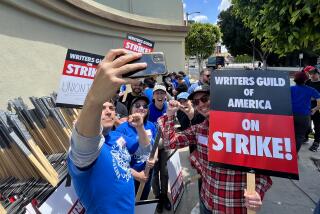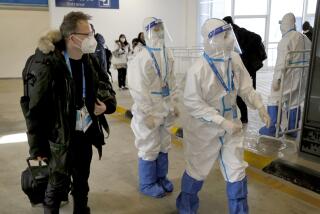Wait watchers
- Share via
Life is not fair, neither are lines.
At public events, men quickly file in and out of restrooms, while women develop age spots standing waiting their turn. At fast-food restaurants, patrons who enter first often are served after those who arrive later. On freeways, the daily incidents of what amounts to line jumping are too numerous to contemplate.
In this, the high season of waiting, there may be comfort in knowing that scientists at some of the nation’s finest universities diligently study the web of lines that compose the circle of modern life. Broadly known as the science of queuing, researchers in mathematics, physics and psychology strive to ease the widely felt burden of lines and impose some semblance of order and justice upon them. They have their work cut out for them; from grocery stores to congested roadways, estimates are that over a lifetime the average American spends two to three years in line.
The field’s main goal isn’t necessarily to eliminate but rather to maximize the actual and perceived efficiency of a line. The techniques, employed by both the private and public sector, have saved or earned hundreds of millions of dollars while simultaneously preventing countless complaints. And its applications go far beyond the immediacy of the returns line at Target and extend from telecommunications centers to airport control towers, and most recently to homeland security.
“It’s one of the world’s most important hidden professions,” said Richard Larson, a professor at MIT who has consulted with the U.S. Postal Service, Fortune 500 companies and many others on how to improve service in lines. “Not a lot of people, even other scientists, really know about us.”
Seasonal shoppers and gift givers probably don’t know about the hidden hand of queuing science either. But it’s there. When L.L.Bean was losing customers to busy signals and holds of up to 10 minutes at a time, it was there to increase -- in a cost-efficient manner -- the number of phone lines and employees taking phone orders, especially during the three weeks before Christmas. When United Parcel Service, the world’s largest package delivery company, was having problems coordinating its overnight service, it was there to reconfigure routes and schedules for about 160 aircraft and 17,000 destination points for on-time deliveries.
The science translates into more than just better service; it can also save lives. Larson is working on a project for the Department of Homeland Security that will aid first responders in managing emergency resources in the event of a terrorist attack or natural catastrophe. In addition, the model will also show how to best use emergency services for ordinary emergencies, such as fires and heart attacks.
“You can’t predict the idiosyncratic details of a situation, so you’ve got to leave room for management discretion,” said Larson, who discussed the ideas at a national conference sponsored by USC’s Center for Risk and Economic Analysis of Terrorism Events last month. “But you’ve got to account for the big things. How do you get 200 people over here, 50 people over there? If you don’t, you’ve got chaos, and it’s precious seconds slipping away with people’s lives on the line.”
Are we there yet?
Although evolutionary biologists believe early humans began lining up at least 30,000 years ago, the study of queues didn’t truly begin until the early 20th century. Then a Danish telephone engineer named A.K. Erlang faced the eternal question of queuing, how to ration a scarce resource -- in his case, available telephone lines.
Erlang’s answer, a series of complex mathematical formulas, for establishing queue order for telephone callers gave birth to queuing theory, the hard science side of the field. The elaborate calculations have seamlessly relieved congestion in everyday lines, whether it’s in person, on the phone or in traffic. By understanding the relationship between demand, its varying intensity levels and the pool of potential servers, queuing systems can be designed to make sure a grocery store has a cost-efficient number of clerks for a Monday night, a telephone caller gets an immediate dial tone on Mother’s Day and a traffic light remains green a few seconds longer at a particularly busy intersection.
Of course, if you can’t reduce actual wait times and lines any further by crunching numbers, then the psychological side of queuing science has shown you can at least seem to have done so. Along these lines, a New York City high rise in 1955 has earned a special status in queuing lore.
The apartment building’s residents were complaining about the long waits for elevators, particularly during morning and evening “rush hours.” The best solution -- also grossly impractical and expensive -- was to tear down the building, which was poorly designed for heavy elevator traffic, and replace it with a new one. A consultant whose name has been sadly lost to history came up with a much cheaper and highly inspired way out -- installing floor-to-ceiling mirrors in the building’s elevator lobbies. Instead of obsessing about the elevator, residents began distractedly gazing at themselves. Within a week, complaints dropped to near zero.
“It was a stroke of genius,” Larson said. “It showed the problem wasn’t the delay in elevators but the complaints about the delay of the elevators.”
Coincidentally, that same year also marked the opening of Disneyland, widely recognized as one of the world’s most skilled organizations in managing lines. Unlike elevator lobby mirrors, which merely divert people, Disney transformed the drudgery of waiting in line into bona fide entertainment.
“Disneyland changed the way huge numbers of people experience a line,” said Mark Gottdiener, professor of sociology at the University of Buffalo, State University of New York, who has written about Disneyland’s crowds and use of space.
Drawing on queuing theory and contributing its own innovations, the Indiana Jones Adventure offers a textbook example on the smart way to handle lines. When the attraction debuted in 1995, wait times could be as much as three hours for a ride that lasted less than four minutes. Complaints were almost nonexistent -- an incredible feat considering we live in a culture in which horns start blaring the nanosecond a traffic light turns green.
In geometry, the shortest distance between two points may be a straight line, but in queuing science that’s heresy when long waits are concerned. If Disney guests saw what a one-hour wait looked like in a continuous single-file line, they’d be too demoralized to enter it, research suggests. That’s why the Jones ride repeatedly cuts back and forth, and turns around bends and corners to prevent guests from ever spotting the front.
The ride adroitly manages expectations as well, a basic concept in the science of queuing. By posting estimated wait times along the way, Disney helps guests make an informed decision about joining. In this environment, lines are free to become “a social event that passes the time,” said Kris Theiler, director of operations, planning and integration for Disneyland Resorts, who is responsible for smooth-running lines. “It’s good family time.”
Since 1999, however, families can opt to do more than stand in line together thanks to another advance called Fastpass, in use at the Jones and about a dozen other rides as well. The virtual queuing program provides guests with a computer-assigned boarding time for an attraction, freeing them from the inconvenience of standing in a long line. They simply return at the designated time, wait a few minutes and board the ride.
Disney won’t discuss the system further because they’re being sued by a Tennessee man who claims the company stole the idea from him. Since Disney implemented it, many other theme parks have install similar line-reducing programs, which have proved very popular with visitors.
Are we having fun yet?
While it seems counterintuitive, lines themselves can increase the fun factor, according to researchers; as long as it isn’t too painful, a line can increase the value of whatever is at the end.
“It’s one of the oddities about lines, even though we say we don’t like to wait, it serves to establish the value of something,” said Bob Levine, a professor of psychology at Cal State Fresno who has written about the social hierarchy of lines. “Getting that hard-to-get ticket for a rock concert makes the show sound better.”
Even Disney officials acknowledge lines aren’t always bad. “It’s good for guests to see others in line,” Theiler said. “It tells them the ride is popular and worth the wait.”
But all efforts to construct an orderly line can quickly be for naught if someone attempts to violate the first come, first served rule. In other words, if they jump the line. While some other cultures -- and New York City subway riders -- do not abide by the rule, in the vast majority of the United States it is a deeply held tenet that one tramples over at great personal risk.
“It can quickly turn into something out of ‘Lord of the Flies,’ ” Levine said. “Lines become their own little worlds, and for better or worse, rules usually get enforced.”
Lines need not turn violent to fail, say queue researchers. Poorly managed ones can also cause stress and smoldering anger -- an aftereffect that can lead to customers abruptly leaving or vowing never to return because of bad service.
Fast-food restaurants, for example, force patrons to choose from a multitude of lines where they must hope theirs is the fastest. The greater the number of lines, the greater the odds against it. Let’s say a customer at a fast-food restaurant must choose from, say, six lines. There’s only a 1 in 6 chance of that, which means that someone who arrived after them had a good chance of being served first. That’s why banks and many other businesses favor serpentine lines where customers wait for the next available server.
There are, however, exceptions to the “first come, first served” rule that don’t spark outrage. Triage in hospital emergency rooms, grocery store 10-items-or-less express lanes are socially acceptable, while those willing to pay more -- first-class airline seats, electronic payment toll-road systems, valet parking -- are allowed to wait less.
The Internet has given reason for others to rejoice when it comes to waiting in line. From holiday shopping to the onetime black hole of the DMV, online services now enable the rest of us to join the rich and famous in skipping lines.
And the opportunities are only going to expand.
“Name almost anything, and now you can avoid the lines,” Larson said. “The DMV used to be a laughingstock. Bring a lawn chair, they used to say. Now, you can do almost everything online and get a discount!”
There’s been progress certainly, but it’s not time to break open the Moet & Chandon just yet. The greatest challenge bearing down on the science of queuing -- as any Angeleno can tell you -- is traffic.
“The sum of queuing delays in traffic can exceed all the other delays in your life combined,” Larson added. “That’s the great unsolved riddle.”






